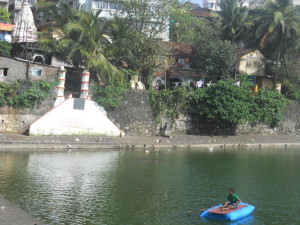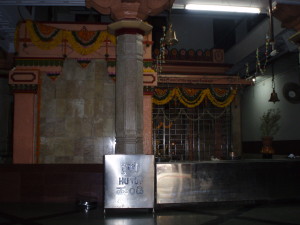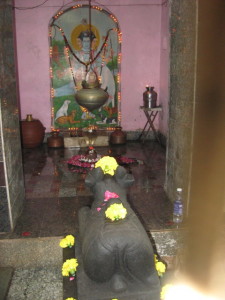Walkeshwar
This is the swayambhu lingam at the highest point in Mumbai, Walkeshwar.
Legend
Legend has it that Hindu god, Ram paused at that spot on his way from Ayodhya to Lanka in pursuit of the demon king, Ravana who had kidnapped his wife, Sita. Then Lord Rama was advised to worship Shiv linga and he is said to have constructed the original linga of sand, after getting tired of waiting for his brother, Lakshman to bring an idol. The name is etymologically derived from the Sanskrit word for an idol made of sand — Valuka Iswar, an Avatar of Shiva.

As the story progresses, later when Ram was thirsty, as there was no fresh water readily available (only sea water), he shot an arrow and brought Ganges over here. Hence Bana (arrow in Sanskrit) Ganges. The water that feeds the tank stems from an underground spring at that spot, despite its proximity to the sea.
History
The temple and the attached fresh water Banganga Tank were built in 1127 AD by Lakshman Prabhu, a Gaud Saraswat Brahmin minister in the court of Silhara dynasty Kings who ruled Thane, and the islands of Mumbai during 810 to 1240 AD. The temple was destroyed by the Portuguese during their reign over Mumbai (Portuguese Bom Bahia) in the 16th century. It was rebuilt due to the generosity of Mumbai businessman and philanthropist, Rama Kamath, another Gaud Saraswat Brahmin (known in British records as ‘Kamati’) in 1715. The main temple has been substantially reconstructed and many smaller temples have come up around the Banganga Tank. By 1860, the temple started attracting greater crowds and 10 to 20 other temples had come up around it and 50 dharamshalas.
Even today the temple itself and much of the property in the complex belongs to the Gaud Saraswat Brahmin Temple Trust.
Worship
The temple is generally busy every month only during the full moon, and at Amavasya (new moon).
Jeeva Samadhi
Walkeshwar also has the jeeva samadhi of Madhavendra Tirtha of the Madhva lineage, in Kashi Math.
He entered samadhi live around 300 years ago.

Cemetary at Banganga
the Dashnami Goswami Akhada, or the Banganga Goswami cemetery, as it is more popularly known. This is no ordinary cemetery where all and sundry are cremated (as is the case with all Hindu deaths), but this is a special area reserved for those who have taken the vows of Sanyas (renunciation) – Sanyasis as we know them. Of course, the more popular Sanyasis are those who are the pontiffs of the various mutts in India, but there are others who have lived the life of normal householders, but have taken the path of renunciation later in life. There are innumerous samadhis of sannyasins in this cemetary, but the main place in the heart of the cemetary is the Jeeva Samadhi(live tomb) of the founder of this cemetary.
Noted samadhis of recent saints include Nisargadatta Maharaj, Ranjit Maharaj amongst many others.
Courtesy: http://anushankarn.blogspot.in/2009/08/final-resting-place.html
http://wikipedia.org

